Rooster Tails: The Answer For River/Stream Trout
By: Bill Herzog
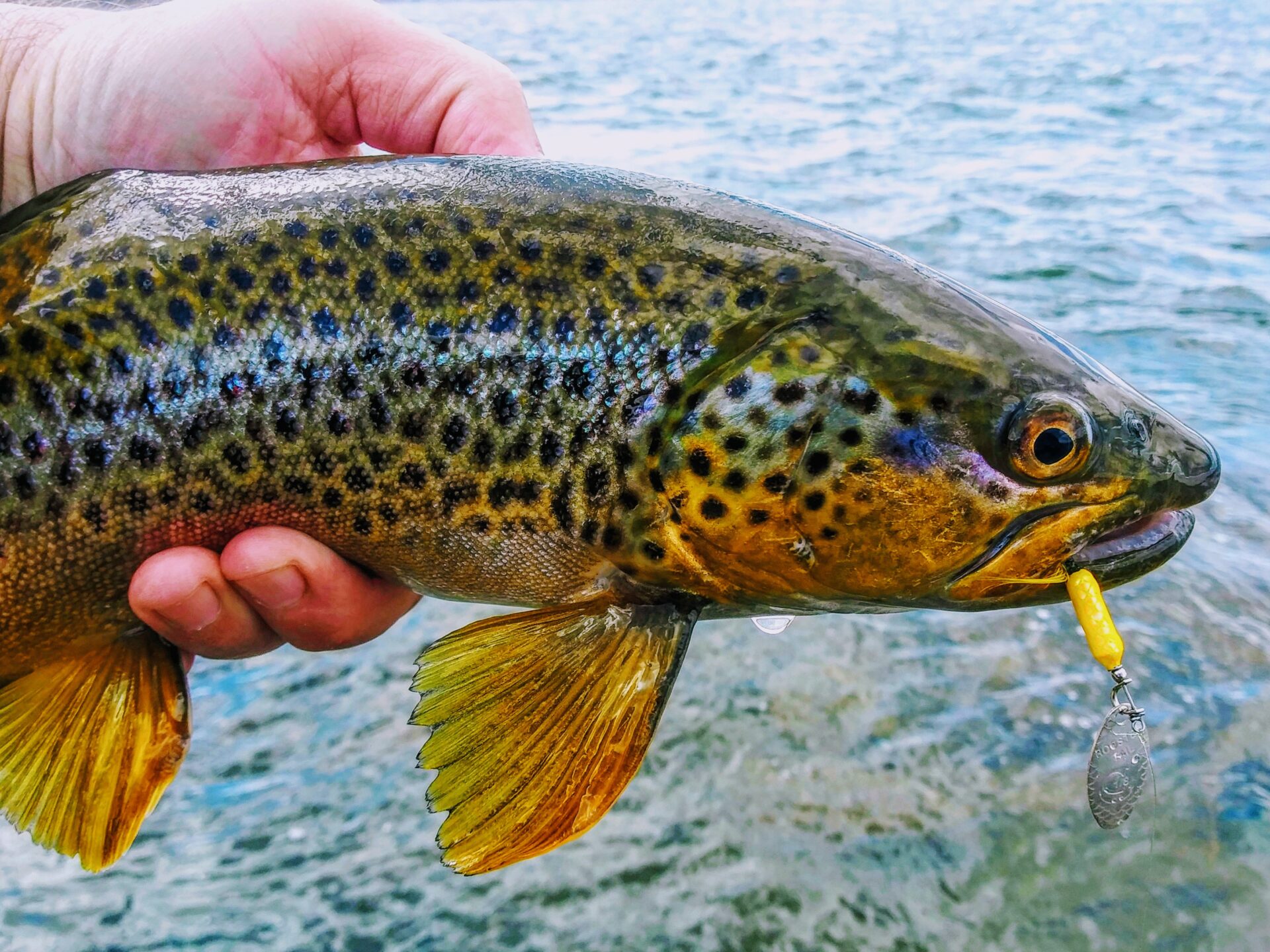
A spinner will cover more water faster,
always finding larger/more aggressive trout.
Yakima Bait’s Rooster Tail spinners fill that order.
My great friend JD Love has moved back to Montana, retiring from the rigors of a winter coastal steelhead guide to the more laid-back vocation of trout guide. I call him often from my homeport of Yakima, WA to compare river stories from our trout adventures. He always makes me cringe when he tells me of oversized browns, rainbows and cutthroat his clients hook on flies the size of the period at the end of this sentence. Right angle nymphing with a single-handed fly rod, a bobber and dual weighted nymphs are deadly effective, easy for the novice to use and have decent success. I just can’t do it…
Two reasons…first, at my ancient age I absolutely cannot tie on any fly smaller than a #12 without a proton microscope. Nothing against it, I just don’t dig it. That is why I spend my time on trout rivers drifting small spinners, primarily Rooster Tails.
Why spinners? You must cover far more water to find trout, especially larger ones when bites are far between. You need a technique that is effective as well as being one that covers the water thoroughly at a fairly fast pace. Spinners, especially Rooster Tails, feature flash, and that “pop” is the ticket. There’s a thing called “attraction radius”, the flash the rotating blade gives off. Let’s say, in very clear water, the blade’s flash can be seen by trout 6 feet away, where a small fly even though most of the time is more effective in getting numbers of bites can only be seen 2 feet. Do a bit of math and you can see how the fly needs to be presented many more times along a stretch of holding water to be spotted by trout that the flash of a blade. Work this calculation out a bit and time spent on each run is cut by more than half, which means far more water is combed in a day, therefore far higher odds of finding numbers of trout. The number one reason? The grabs from aggressive trout on Rooster Tails are breath-robbing, eye-
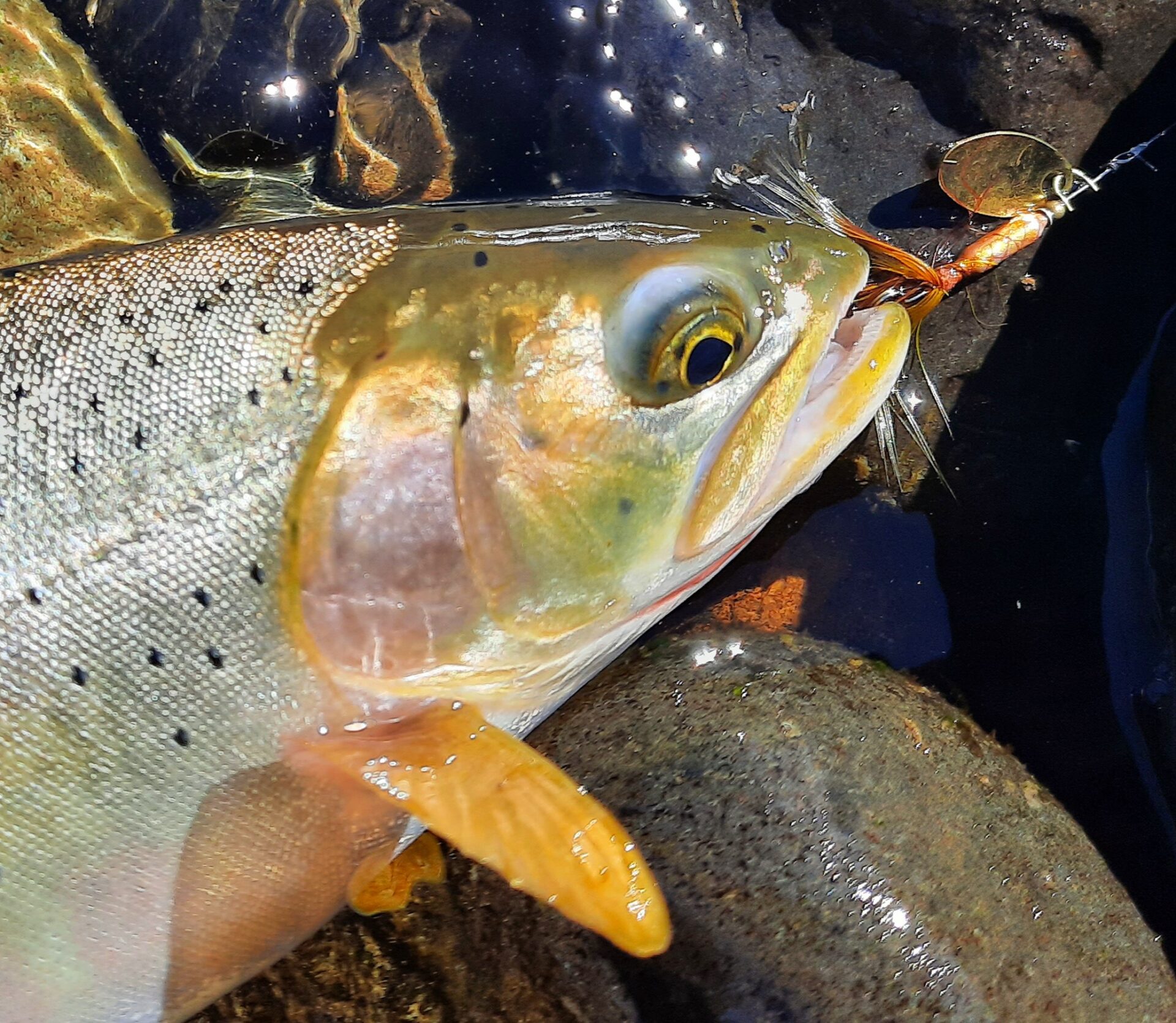
popping, rod-creaking strikes!!
I used this same “formula” for many moons, it’s the best way to work as much water as possible during our precious times river side.
Which size/colors/finishes of Rooster Tail spinners are the best? There are a dozen or so trout spinners out there commercially available, some high quality and some just cheap garbage. Your spinner choices must fall into a few categories to be game changers. First, they gotta be readily available, second, they must be available in proper colors and blade finishes to cover almost any situation and third, they must be the correct weight to fish effectively. I choose the Rooster Tail by Yakima Bait, as it fits snugly in each category. The Rooster Tail spinner just looks trouty, its hackle tail gives it a profile and action no other trout spinner features. Plus, it’s made in my backyard, so there may be a bit of homerism in there somewhere.
Presenting the Spinner for Trout
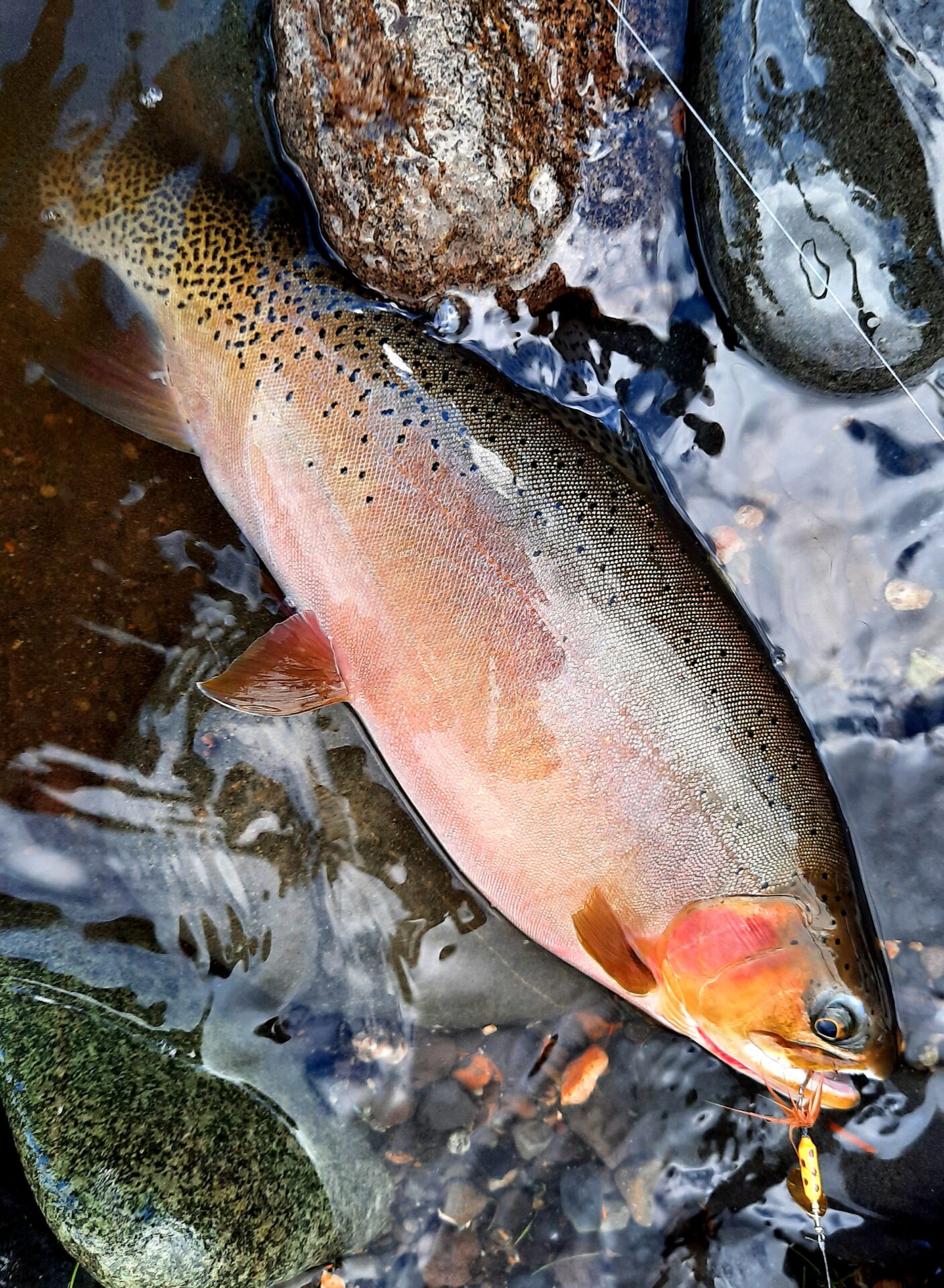
Yeah, you can just fire it out there and start reeling and perhaps the planets align and an aggressive fish or two may reward you eventually, but like Dean Wormer says, that is no way to go through life, son. One of the main reasons I choose the Rooster Tail is its weight paired with blade size. The three sizes that get 95% of use in my vest are the 1/6th, 1/8th and 1/16th ounce models. Now those may seem light, and for casting distance and getting down immediately into short or tight edges, it is. Easily fixed by proper rigging, which we will cover in a paragraph or two.
Almost without exception, positioning is everything. Remember, a spinner creates a lot of lift and resistance due to the revolving blade. Your job is to negate the “push” by allowing the spinner to travel downriver with the current. Position yourself directly across and slightly downriver from your target water. Cast slightly beyond the spot you would expect a trout to lie. On most trout rivers, unlike steelhead they may forego laying out in middle of a riffle and hug the bank. That’s where the food comes from, either insects or small forage fish like sculpin…and where the biggest trout in the crick live. Larger trout have a different diet than smaller ones, I’m not sure what the spinner simulates but I imagine it could be a small fish or the like and a large caloric shot.
A typical presentation all day long is cast the spinner as close to the bank/downed trees/boulders as you possibly can. Accuracy is a premium when spinner fishing for trout in rivers. Narrow edges in current right tight to the bank are your A1 target spots. The edge seams are the top producers. Chances are that pattern stays constant in your trout streams as well.
When your Rooster Tail enters the water, allow it to free fall for a second or two before swiftly gathering all slack and allowing the blade to begin to spin. Most trout, especially the hungry aggressive ones, with slash at the lure on the drop while the blade is merely wiggling. Be ready for this, it is a common grab and now is when your hook sharpening skills will be tested. Keep your rod tip low, at around 9 o’clock and pointed somewhat at your lure, all the ready to set a hook. As the spinner sinks, a slow reel to keep the lure moving smartly along just above the bottom and moving at or ever so slightly slower than current speed. Follow the Rooster Tail’s down current movement with the rod tip. After the lure goes past your position, the blade spin increases to create lift and the lure nears your side, watch to make sure there are no chasers and reel in. Move down several steps (remember the attraction radius) and hit a new spot. If there is a trout holding it will do one of two things, either crash down on the spinner in the first few seconds or nobody is home. Move on.
Rigging the Spinner
I choose these three weights/sizes of Rooster Tails (1/6th, 1/8th and 1/16th oz.) because their size is ideal year around for trout ranging from palm sized to double-digit pounds. These sizes cover all types of water, from shallow tailouts/head-ins (smaller weights/blades) up to longer casts/deeper water (1/6th up to ¼ ounce). The blade, body and tail are not too large to consider as food and not too small/light for all around use.
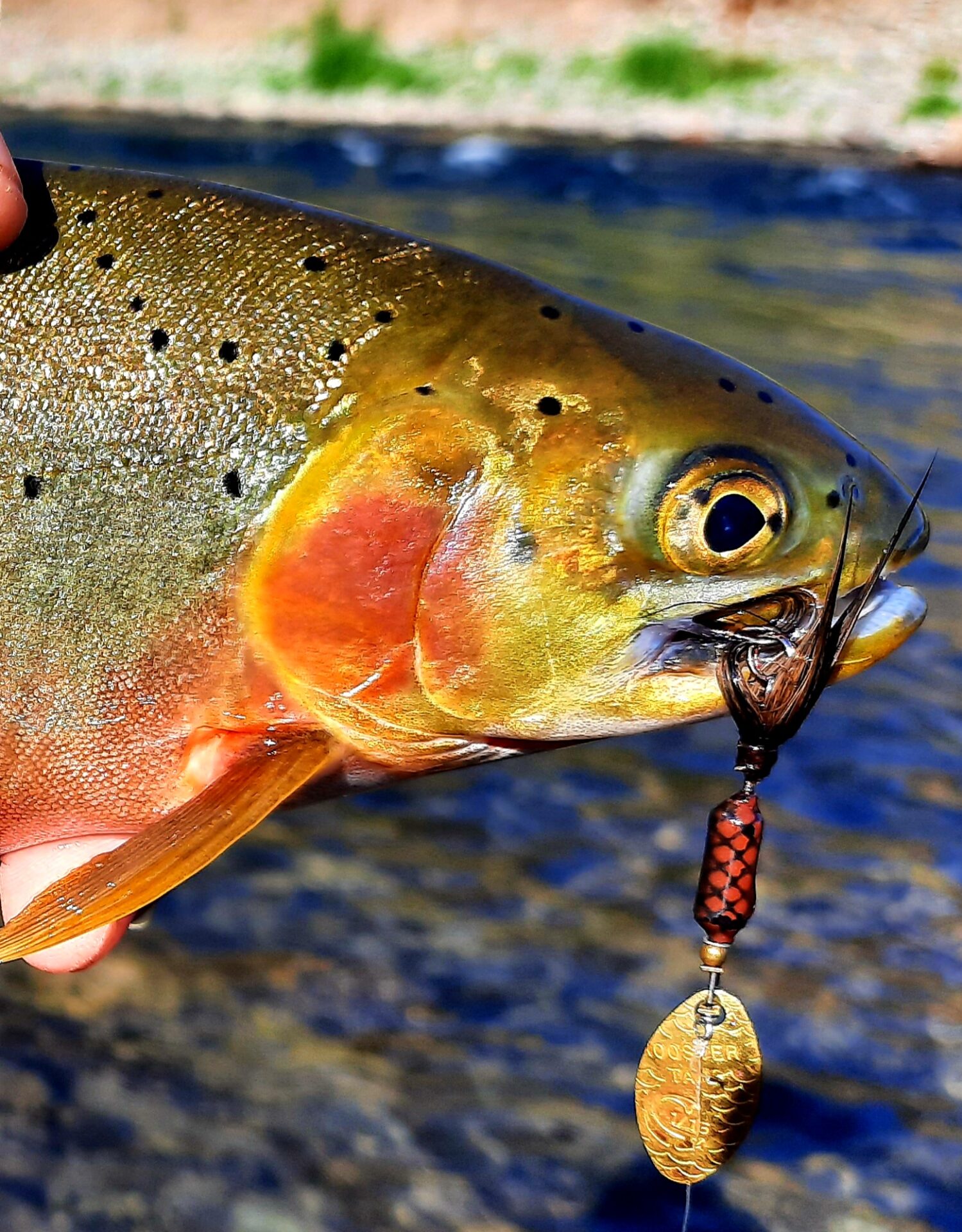
For rigging, start at the bottom and go up. If trebles are legal, the stock trebles on the Rooster Tail are great. When they go dull (and all hooks will) replace the treble by cutting off the eye of the treble, place the smallest split ring you can find on the wire loop and add a #10 round bend bronze treble to the 1/16th and 1/8th; place a #8 on the 1/6th. Where singles are the only legal option, carefully cut off that treble, add the tiny split ring and place a #6 siwash single hook. Sharpen the living daylights out of all your hooks as trout are notorious nippers plus most trout are not that heavy and driving a hook home, even a small one is difficult unless your hook(s) are lethal sharp.
I learned through many open division anglers is tie my leader directly to the wire loop on the top of the Rooster Tail instead of a snap swivel. The snap swivel may push the spinner off balance and prevent an immediate blade spin, plus it just makes the spinner (especially Rooster Tails) look unnatural. If you are worried about line twist, as you should with any revolving lure, use a leader approximately 18” long to a swivel. A small #10 black barrel swivel will do, a small ball bearing even better. From trout 8” to 8 pounds my leader of choice is 10# thin high-quality fluorocarbon. Second choice is 6# Maxima Ultragreen. Above the swivel you may add a couple small split shot or do my trick, cut a ½” of 1/8th hollow core pencil lead and slide it on the main line, a tiny 2mm bead above the swivel to protect the knot. Just enough weight to help get casting distance and get the lightly weighted Rooster Tails down quickly.
Rod, Reels, Lines
Rod, reel and line choice have been the same for me for five years now. A 7’, 6” light, fast action spin rod rated for 4 to 8# lines have been my “working tools” when casting Rooster Tails. Paired with a 1000 size spinning reel is pretty darned the cosmic funk. Mainline is Berkeley Nanofil 10# white. It casts better than any mono, DOES NOT TWIST like mono, has the diameter of 6-pound test with no stretch the feel of the blade spin is in your hands. Place a 7 foot “top shot” of 8-pound Maxima uni-knotted to the Nanofil to the swivel and you are in business. Regardless your choice of outfit, make sure its light and mirrors this style of rod and reel closely.
Choosing The Right Spinner Colors/Finishes
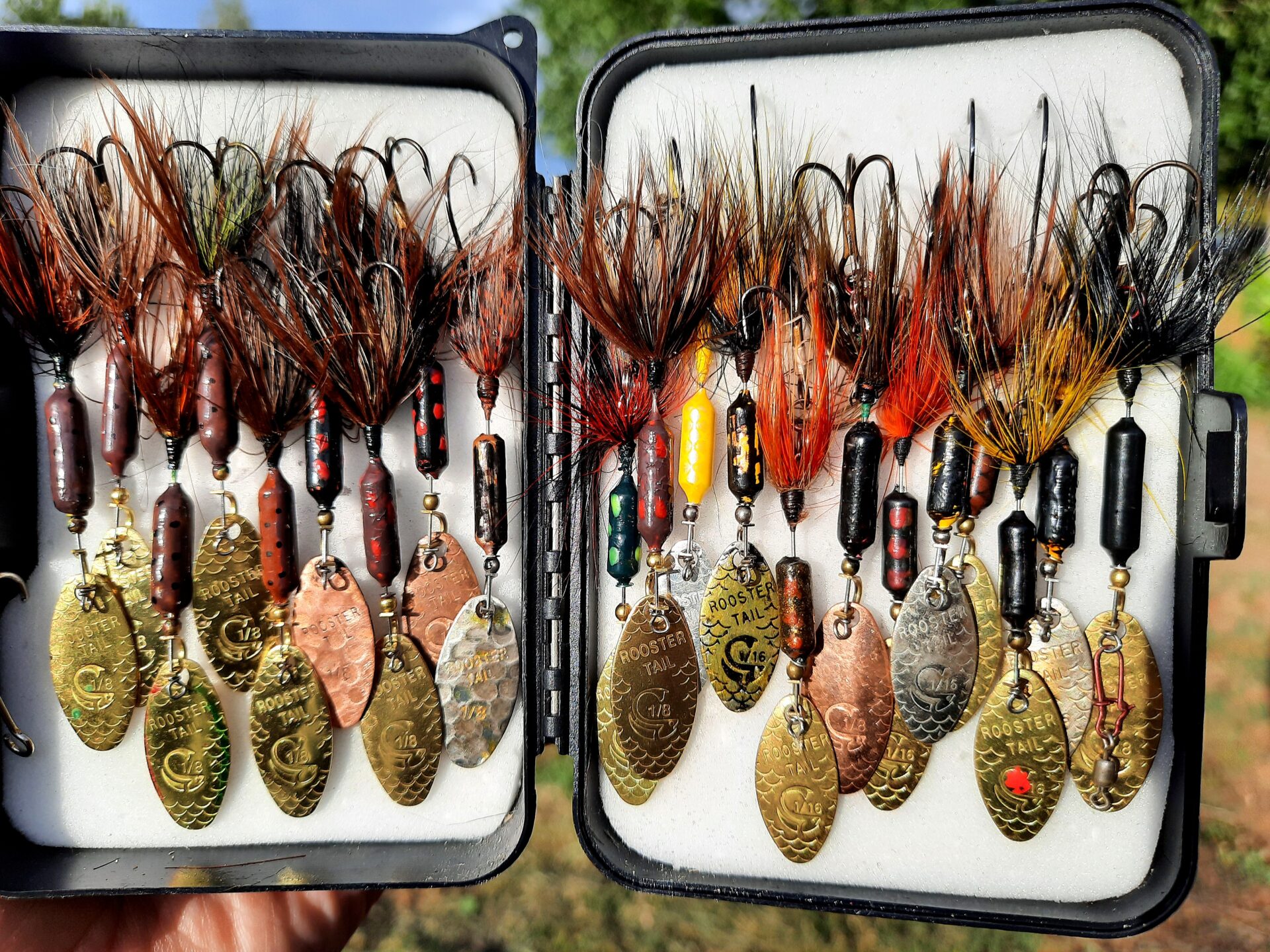
When your stream/river trout fishing is done under fairly clear and warm (high 50s to low 60s water temps), a great rule of thumb is to keep it subtle for blade finish and body/tail colors. Early morning or towards evening under low light you can get away with a bit more flash, even run a silver blade until the sun peeks over the hill. Ninety percent of the time think brass blade. Brass gives off 60% of light, enough to attract trout without spooking them over their “attraction threshold”. For body/tail colors of Rooster Tails, think dark and subtle. Dull yellow, browns and black in any combo will do. Try the BR (Brown); BRTR (Brown Trout); GH (Grasshopper); MF (Mayfly) and BLCD (Black Coachdog). I catch trout all season on Rooster Tails with these combos in a dozen configurations under bright sky/clear water, the only constant are the colors of blades and body/tails. When the water has some color (3 to 6 feet of visibility) or runs on the cold side (48 to 36 degrees) go with silver plated blades and brighter colored bodies. Try GYL (Glitter Yellow); FWH (Flash White); R (Red); CLCD (Clown Coachdog) and WHR (White/Red). Rooster Tail blades feature real silver plating that reflects 90% of the light, it really pops, making it easier for trout to see and exciting them in colder water.
There is always one ultra-secret that separates us from the other hordes of anglers out there, here’s one I thought I would never give up but…here it is. When fishing the Rooster Tail, where legal, spray the hackle with Rooster Tail Scent Spray. I have not found one flavor to out fish another, but Garlic or Trout/Kokanee work amazing. Also, when legal, tip one of the hooks with a single white Berkeley Gulp maggot. Hook it by the very tip, they last for several casts but usually a trout will grip the spinner immediately.
Go to the Yakima Bait home page and look up Rooster Tail sizes and colors. You will find a dozen or more combinations that will work just dandy for your home stream/river trout.
There is that love of flowing water that most of us just have to have. Hiking the riverbanks, floating in a pontoon, raft or drift boat never gets old. Tossing spinners for trout is just one more way we do what we do. The strike on a Rooster Tail just seems to top every other technique for sheer excitement.
